History
Rhesus macaques (Macaca mulatta; Figure 1) were introduced into what is today Silver Springs State Park (SSSP) in the mid-1930s. Local folklore suggests the monkeys were released while the 1939 movie "Tarzan Finds a Son" was filmed at the site. However, macaques were present in Silver Springs prior to filming, and no rhesus macaques appear in this film. In truth, today's thriving population descended from monkeys intentionally released in the 1930s in an effort to increase tourism to the area.
Silver Springs became a tourist attraction in the 1870s. The clear waters generated by natural springs led to the beginning of glass-bottom boat tours shortly after tourists began visiting the site. In the 1930s the manager of the glass bottom boat operation, Colonel Tooey, is reported to have released approximately six rhesus macaques in hopes they would attract tourists and increase revenue for the boat tours. Not knowing rhesus macaques are proficient swimmers, Colonel Tooey released the macaques on an island in the Silver River. The monkeys quickly swam to the surrounding forests, where their numbers began to increase. Boat operators used food to lure the macaques to the shore to entertain tour patrons. In an effort to increase the population, Colonel Tooey purchased an additional six macaques and released them on the north shore of the river around 1948.
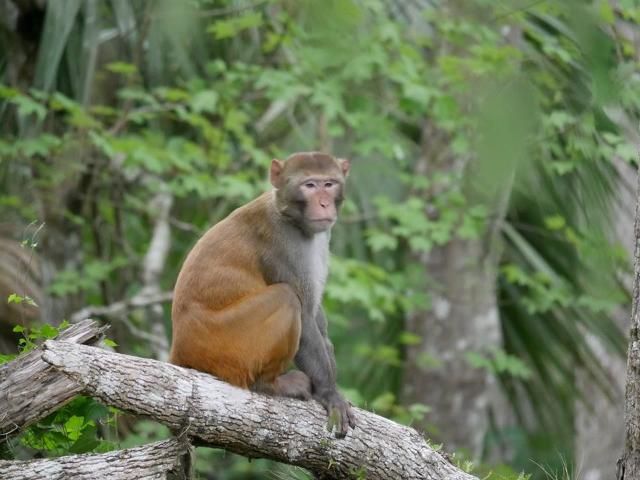
Credit: C. Jane Anderson, University of Florida, 2015
A 1968 study estimated the population of rhesus macaques in the park to be 78 individuals spread between 2 groups. By the 1980s, the macaque population along the Silver River had grown to nearly 400 animals, and the population had spread to the forests adjacent to the Ocklawaha River. In 1984 short-term permitted trapping was initiated in an attempt to reduce the population, during which 217 individuals were captured and sold for biomedical research. In 1985 an additional 20 were trapped and removed by permitted trappers, and in 1986 it is believed an additional 59 animals were removed from the property by trappers without permits. In an effort to slow population growth, 20 female macaques were sterilized in Silver Springs between 1986 and 1990. By the early 1990s rhesus macaques had been sighted as far as 11 miles north and 18.5 miles south of the junction of the Silver and Ocklawaha Rivers.
From 1998–2012 a private trapper, permitted by the state of Florida, captured approximately 830 rhesus macaques between Silver Springs and lands along the adjoining Ocklawaha River (approximately 700 of these were from SSSP) and sold these animals to biomedical research facilities. This practice generated a great deal of public controversy and has since halted. The fall 2015 population size within SSSP was estimated to be 190 macaques, but the size of the population along the Ocklawaha River was unknown.
Rhesus Macaque Ecology and Natural History
Rhesus macaques vary in color from brown to grey, and are lighter in color above the waist than below. They have little to no hair on their faces or rumps. Their tails are relatively short, and like all Old World monkeys, their tails are not prehensile. Adult males (Figure 1) are larger than adult females (Figure 2), standing at about 53.1cm (1.74 ft) compared to females at 46.8cm (1.54 ft). They are quadrupedal, meaning they move on all four legs, but will stand on their hind legs for better visibility.
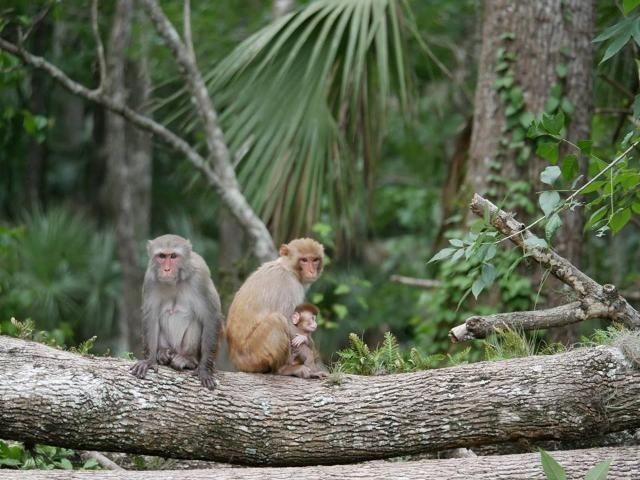
Credit: C. Jane Anderson, University of Florida, 2015
The native range of rhesus macaques is the largest of any non-human primate, ranging from Afghanistan to the Pacific coast of China (Figure 3). Rhesus macaques are adaptable to an exceptionally wide range of habitat and climactic conditions, which has allowed them to establish populations at elevations from sea level to 4000m. They are both arboreal and terrestrial. They are primarily herbivorous but will supplement their diets with bird eggs, invertebrates, honeycombs, and small vertebrates.
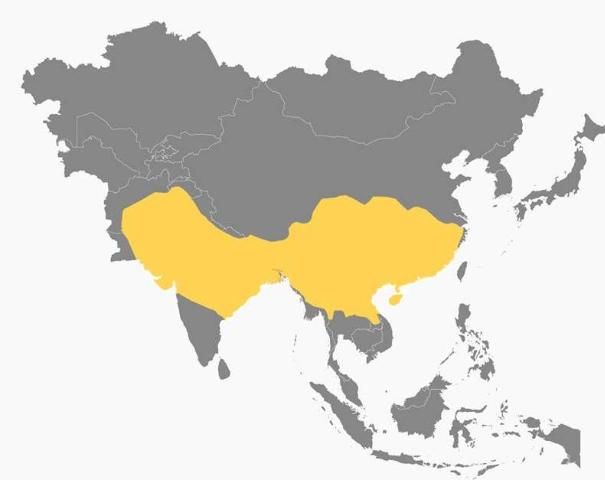
Credit: J. Bickel, adapted from data by the IUCN Red List, 2016
Rhesus macaques live in groups. Each group contains a single alpha male. Females (Figure 2) remain with their natal groups their entire lives. Most males leave their group after reaching sexual maturity, after which they remain solitary, join a bachelor group, or join another established macaque group. Females typically have one infant per year, although they occasionally have twins.
Rhesus macaques thrive in human-dominated areas. They frequently raid crops and in many areas are regarded as agricultural pests. In some regions of their native range they are regarded as sacred. They are often fed by humans in cities and around temples, allowing their populations to grow to extremely dense numbers. In forested regions of their native range, rhesus macaque groups typically contain around 30 individuals with population densities around 35 macaques/km2. In urban areas, rhesus macaque groups may increase to over 75 individuals per group with population densities around 200/km2.
Rhesus Macaques as an Invasive Species
Rhesus macaques introduced into other parts of the United States have caused environmental and economic damage. A population of over 3,000 free-ranging rhesus macaques is maintained on Morgan Island, South Carolina, for biomedical research. Tidal creeks surrounding this island have been found to have elevated levels of E. coli and fecal coliform bacteria due to the monkeys. Laboratory animal supply company Charles Rivers Laboratories introduced rhesus macaques to two islands in the Florida Keys in the 1970s. These animals destroyed red mangroves growing on the islands, which led to shoreline erosion and incited long-standing legal battles between Charles Rivers Laboratories and the state of Florida; the animals were subsequently removed between 1999 and 2000.
Rhesus macaques were introduced to the Isla Desecheo National Wildlife Refuge, Puerto Rico, in 1966 to study their adaptations to a novel environment; they were considered a significant ecological threat by 1970. By consuming bird eggs and chicks the macaques decreased populations of four species of shore birds. A study by the US Department of Agriculture found introduced rhesus macaques and patas monkeys in southwest Puerto Rico cause nearly $300,000 in crop damages annually and over $1 million in management costs. The Puerto Rico Department of Natural Resources and Environment and the USDA currently trap and euthanize these animals as a precaution against further ecological and economic destruction.
Management and Potential Impacts in Silver Springs State Park
The rhesus macaques in Silver Springs State Park have been documented consuming nearly 50 species of plants (Figure 4). The macaques were also observed consuming quail eggs placed in artificial nests during an environmental impact study (Figure 5), indicating they may be a threat to breeding birds. It is unknown whether, or to what extent, they are currently threatening native wildlife by predation or competition.

Credit: C. Jane Anderson, University of Florida, 2015
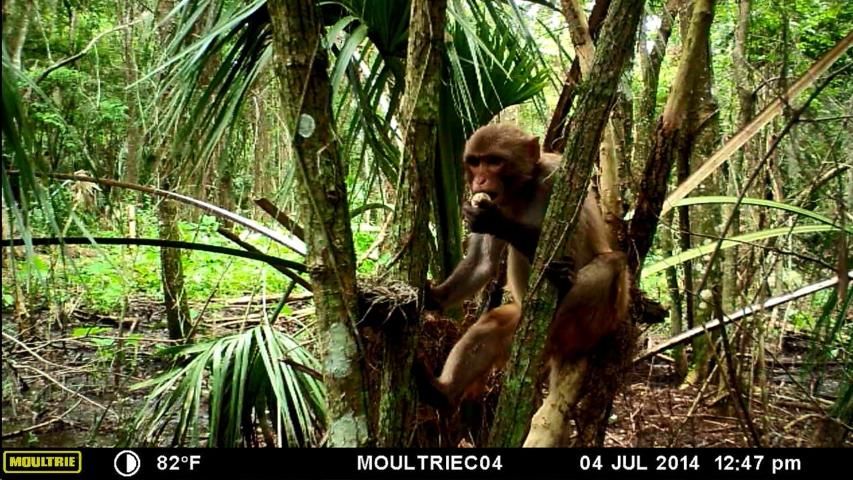
Credit: C. Jane Anderson, University of Florida, 2015
In addition to the potential threats to native natural resources, introduced rhesus macaques may pose risks to human health. The rhesus macaques in Silver Springs have tested positive for Herpes B Virus. This virus is mostly asymptomatic in macaques, who only shed the virus intermittently. Infected animals must be actively shedding the virus to spread it to others. The virus is spread by transmission of bodily fluids, which is possible through bites and scratches or other contact with bodily fluids. There are no reports of other wildlife species contracting the virus from macaques.
The risk of transmission of Herpes B from macaques to humans is uncertain. There has never been a confirmed report of a human contracting Herpes B from a macaque in the wild, despite at least 18 reports of macaque bites or scratches in Florida and countless incidents in the macaques' native range. However, there have been 50 incidents of human Herpes B Virus infection from macaques in laboratories, almost entirely from bites and scratches from infected animals. Nearly half (n=21) of these cases were fatal, and other infected humans suffered permanent neurological damage. It is unknown why there has only been documentation of human infection from macaques in laboratories and not from wild macaques, despite prevalence of Herpes B infection in both captive and wild macaques. Future research is critical to better understand the ecology and threats of this virus in and around Silver Springs State Park as well as other locations where macaques occur.
For the safety of humans and macaques alike, visitors to SSSP and boaters on the Silver and Ocklawaha Rivers should avoid contact with macaques and only observe them from a safe distance. Visitors should never feed the macaques, as feeding them may cause them to become aggressive towards humans (Fig. 6). Anyone bitten or scratched by a macaque should seek immediate medical care and follow the guidelines provided by the Center for Disease Control: https://www.cdc.gov/herpesbvirus/firstaid-treatment.html
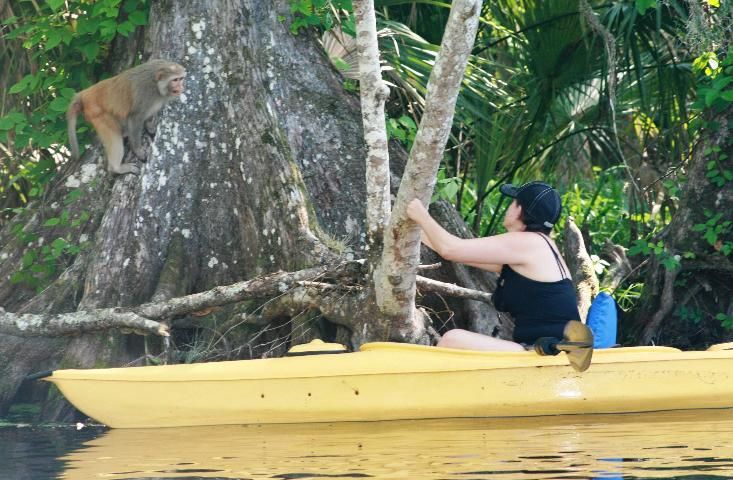
Credit: C. Jane Anderson, University of Florida, 2015
Purchased in 1985 by the state of Florida, the 4,685 acre SSSP is now publically owned with a mandate to preserve natural resources, including native plant and animal species. Managers of SSSP are thus in the difficult position of determining the best strategies for managing the population of non-native rhesus macaques. Many park visitors enjoy observing the macaques and support their continued presence in the park. However, research on the behaviors, potential for population growth, threats to human health, and environmental impacts of this population is needed to make informed management decisions.
Suggested Readings and Online Resources
Cawthorn Lang, K.A. 2005. University of Wisconsin – Madison National Primate Research Center. "Rhesus Macaque (Macaca mulatta) Factsheet." https://primate.wisc.edu/primate-info-net/pin-factsheets/pin-factsheet-rhesus-macaque/. Accessed August 26, 2022.
Center for Disease Control and Prevention. 2014. "B Virus (herpes B, monkey B virus, herpesvirus simiae, and herpesvirus B)." https://www.cdc.gov/herpesbvirus/
Florida State Parks. 2015. "Welcome to Silver Springs State Park." https://www.floridastateparks.org/silversprings
Montague, C.L., S.V. Colwell, H.F. Percival, and J.F. Gottgens. 1994. Issues and Options Related to Management of Silver Springs Rhesus Macaques. Technical Report #49 https://aquadocs.org/bitstream/handle/1834/19106/OCRMontague_C_1994.pdf?sequence=1&isAllowed=y. Accessed August 26, 2022.
Puerto Rico Department of Natural Resources and Environment. 2014. "Project to Control Primates in Southwest Puerto Rico." https://www.drna.pr.gov/programas-y-proyectos/proyecto-para-el-control-de-primates-en-el-suroeste-de-puerto-rico/. Accessed August 26, 2022.